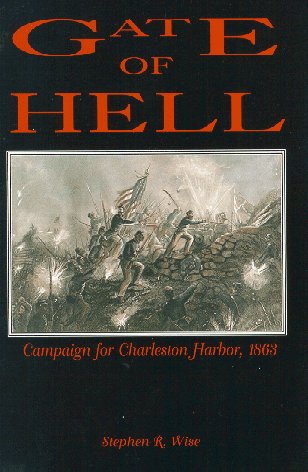The movie Glory popularized in dramatic fashion the heroism of the 54th Massachusetts regiment in the assault on Ft. Wagner. Now Stephen Wise, museum director and South Carolina historian, presents the full story of the assault on Ft. Wagner within its larger context. Battery Wagner, as the author notes, was not a true fort, but only an artillery fortification helping to protect Charleston harbor. It was located on Morris Island (now washed away by the sea tides) just south of Ft. Sumter. It came under attack because Northerners and especially the naval command in the Lincoln administration wanted to capture Charleston. The city offered a vital port for the Confederacy. But its symbolic significance as the bastion of secession caused many Northerners to regard Charleston as a more valuable prize than Richmond. This book is the story of the Union scheme to capture Charleston and its surrounding harbor fortifications.
Stephen Wise has found a story with lots of interesting characters. Obviously Robert Gould Shaw and the African Americans of the 54th Massachusetts play a role in the book. We also meet Clara Barton; the three top naval commanders (Samuel F. DuPont, Andrew H. Foote, and John A. B. Dahlgren); General Quincy A. Gillmore, best and brightest of West Point's class of 1849 and, in 1863, the Union's elite artillery technician; General Pierre G. T. Bueauregard, hero of Charleston in 1861; and dozens of lesser but equally interesting people. Wise has prepared himself well to handle both Union and Confederate sides of the story equally and objectively.
The operation against the defenses of Charleston, namely Battery Wagner and Ft. Sumter, occurred in two phases. First, the grand assault on July 18, 1863, began with heavy bombardment on Battery Wagner from Dahlgren's ships. The Union plan was to capture Battery Wagner on Morris Island and use that position to bombard Ft. Sumter. Gillmore's infantry followed up the naval bombardment with the famed assault led by the 54th Massachusetts. This operation ended in dismal failure with severe losses by the Union attackers and Confederates still holding the fortifications.
The second phase was a siege against Battery Wagner. At this stage, Wise argues, the operation assumed the character of modern warfare. Now "engineers and artillerymen--the technicians of war--were taking control.... Shovels began to replace the rifle and the individual soldier was becoming lost amongst the mass firepower and trenches provided by the artillery and the engineers" (p. 120). The Union Army dug a series of zig-zag trenches that inched toward Battery Wagner. This construction brought Union firepower and soldiers closer to the fortification.
A part of the second phase was the bombardment of Ft. Sumter on August 17, 1863. Gillmore's artillery, now including rifled cannon, pummeled Ft. Sumter. The expert Union artillery reduced the fort's masonry to rubble. But the Confederates used the rubble to rebuild defensive structures and tenaciously held onto the fort.
By early September Union troops were exhausted from the toil, heat, and warfare. An uncoordinated army-navy assault on Ft. Sumter failed and General Gillmore gave up the fight. Several months of vicious fighting brought no real results. The Union controlled Morris Island, but the Confederates still held Ft. Sumter and Charleston remained secure.
Various subthemes run through the book. We see, for example, personalities affecting the coordination of Union naval and land operations. For readers who have paid little attention to the Civil War navies, Wise's tale reveals the Union's expanded usage of ironclad monitors as attack units. One of the strongest features of the book is the discussion of naval and fortification artillery. Wise's delineation of the technical aspects of Civil War artillery is clear even for the novice.
The author presents a number of useful maps and diagrams of Charleston Harbor and its fortifications. My only lament about the book is that land features on the maps are frequently confused with marshlands and the sea.
Wise argues that this campaign initiated the onset of modern warfare. First, he argues that rifled artillery made its impact in this campaign. Second, he asserts that after the first failed assault on Battery Wagner, new techniques such as trench warfare defined the Civil War tactics. He perhaps could have muted his claims by noting that the innovations at Charleston Harbor were only part of the changing nature of warfare in 1863.
 |
|
|
Dr. Stephen R. Wise
, an historian who lives in Beaufort, South Carolina, is the director of the museum and the Cultural Resource Manager for the Marine Corps Recruit Depot, Parris Island, SC. A native of Toledo, Ohio, Dr. Wise received his bachelor degree from Wittenberg University; a master’s degree from Bowling Green State University. and a doctorate from the University of South Carolina where he studied under the late Thomas L. Connelly.
Dr. Wise's Gate of Hell: The Campaign for Charleston Harbor 1863, which received the South Carolina Historical Society award as the best book written in 1994 on South Carolina History.
|
A well-known lecturer Dr. Wise has been the featured speaker on Cunard passenger liners and Windspirit cruises; appeared on the Arts and Entertainment Channel, the History Channel, the Discovery Channel and Public Television productions. He wrote the screen narrative for the Gilded Age Productions film American Iliad: The Siege of Charleston, a docufilm on the Civil War in the Charleston area.
He has received the Daughters of the American Revolution History Medal Award, the Department of the Navy's Cultural Resources Management Award and his cultural resources programs have won three Department of the Navy and one Department of Defense awards for excellence. Dr. Wise teaches history as an adjunct professor at the Beaufort campus of the University of South Carolina and has three times received the adjunct faculty member of the year award. He also serves as an advisor to the South Carolina Battleground Preservation Trust and is currently serving on the board of the Beaufort County Historical Society and the South Carolina Historical Society editorial board.
|
Lifeline of the Confederacy Blockade Running During the Civil War
by Stephen R. Wise; William N. Still, Jr. / Paperback / Sept 1991 / ISBN 0872497992
|

